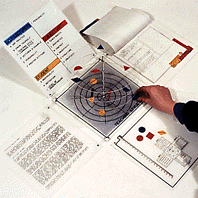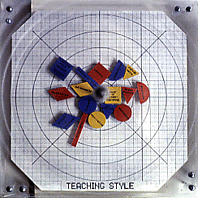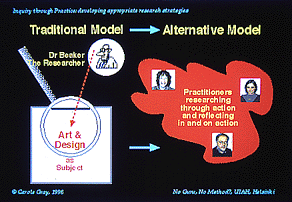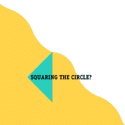

| page 7 of 14
|
 |
 'Teaching Style' game, Ph.D, Gray, 1988 
|
But Research with a big 'R' - formal research for a higher degree - was unknown territory. I was lucky to have Ray MacAleese, who at the time was working at the University of Aberdeen, as my Ph.D supervisor. Ray didn't know much about art and design, but knew a great deal about teaching and learning! Our conversations involved me struggling to explain how we 'taught' in art and design - my own teaching style being described by him as "flying by the seat of your pants!" - and him expounding on the latest teaching and learning theories. We spoke of subjectivity and objectivity, practice and theory, and how reliable and replicatable my research was (or wasn't!). I often worried him by bringing in home-made "visual analysis" tools, and invented strange structures to express my research findings. Our different worlds collided often in our attempts to equate diverse ideas - intuition and reason - we were trying to square the circle! The results of four years research culminated in a respectable social science Ph.D thesis, gracefully adorned by a wacky 3 dimensional construction - a "teaching style game" - and a rather grim video tape! Social Science and Art met - I was definitiely trying to square the circle! When the dust had settled I realised painfully that I had been doing the wrong Ph.D! What I should have been researching was not teaching styles, but learning styles. Ah well - 'the search for iron has often led to gold'! |
| My research was criticised by one artist as being too 'positivistic'. "What was that?" I wondered. Despite Ray's best efforts I was almost completely ignorant of the wider philosophical issues surrounding research methodologies in Science and Social Science. Only in the latter stages of my research degree did I become aware of the crucial importance of adopting an appropriate methodology, even if at the time a really appropriate methodology did not exist for art and design research. This then became my mission - and greatest challenge in terms of truly trying to square the circle. How could an accessible, rigorous mode of inquiry be developed for artists and designers, in order that we could carry out valid and meaningful practice-based research without wearing the straightjacket of reductionism and a white coat and safety goggles? |

|
 previous page previous page |
 next page next page |